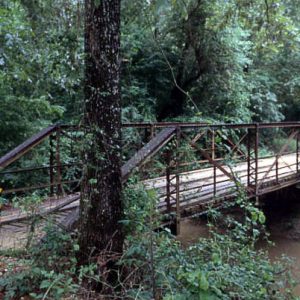calsfoundation@cals.org
DeGray Creek Bridge
DeGray Creek Bridge is a pin-connected Pratt pony-truss bridge located near Arkadelphia (Clark County). Constructed in 1915, it was added to the National Register of Historic Places on January 21, 2010. It is the only known surviving bridge of its type in the state.
The bridge consists of two steel trusses, seven feet tall and twelve feet apart. A steel deck substructure is attached to the trusses, and pins hold the sections together. The deck is covered by wooden planks. This bridge is connected to the banks of the creek by concrete and is a single lane wide. The bridge and similar bridges were prefabricated to be constructed in a manner that would allow them to be quickly and easily put together, deconstructed, and moved if needed. The weight limit on these bridges was lower than that for riveted bridges, but this was offset by the lower cost and ease of construction associated with the pin bridges.
The DeGray Creek Bridge is located northwest of Arkadelphia along County Road 50, also known as Hubbane Road. The bridge was likely purchased by the county in 1915 from the Hope Bridge Company and was constructed by the Stupp Brothers Bridge and Iron Company. The county purchased three bridges at the same time, each costing between $940 and $1,200. The bridge was originally located on another county road northeast of its current position. The construction of DeGray Dam and Lake in the 1960s flooded the area where the bridge was located, necessitating a move of the bridge to its current location.
The bridge continues to be open to local traffic in the twenty-first century.
For additional information:
“DeGray Creek Bridge.” National Register of Historic Places registration form. On file at Arkansas Historic Preservation Office, Little Rock, Arkansas. Online at http://www.arkansaspreservation.com/National-Register-Listings/PDF/CL0960.nr.pdf (accessed March 23, 2018).
Richter, Wendy, et al. Clark County Arkansas: Past and Present. Arkadelphia, AR: Clark County Historical Association, 1992.
David Sesser
Henderson State University
 Early Twentieth Century, 1901 through 1940
Early Twentieth Century, 1901 through 1940 Historic Preservation
Historic Preservation DeGray Creek Bridge
DeGray Creek Bridge  DeGray Creek Bridge
DeGray Creek Bridge 



Comments
No comments on this entry yet.